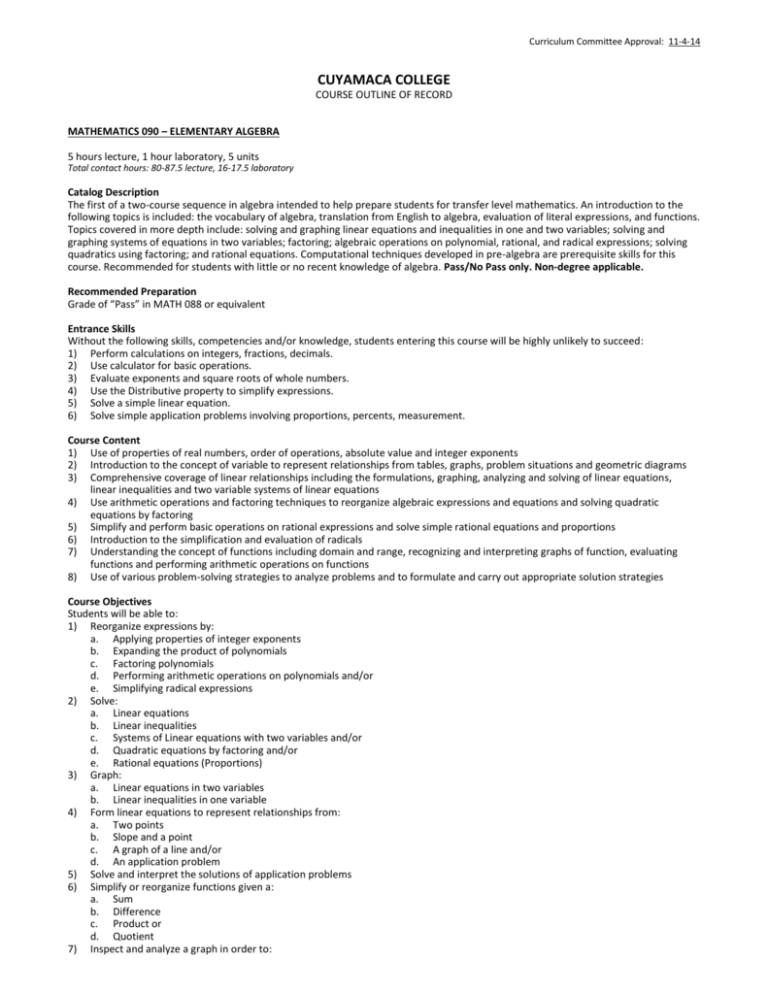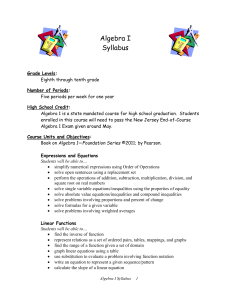Math 90
advertisement

Curriculum Committee Approval: 11-4-14 CUYAMACA COLLEGE COURSE OUTLINE OF RECORD MATHEMATICS 090 – ELEMENTARY ALGEBRA 5 hours lecture, 1 hour laboratory, 5 units Total contact hours: 80-87.5 lecture, 16-17.5 laboratory Catalog Description The first of a two-course sequence in algebra intended to help prepare students for transfer level mathematics. An introduction to the following topics is included: the vocabulary of algebra, translation from English to algebra, evaluation of literal expressions, and functions. Topics covered in more depth include: solving and graphing linear equations and inequalities in one and two variables; solving and graphing systems of equations in two variables; factoring; algebraic operations on polynomial, rational, and radical expressions; solving quadratics using factoring; and rational equations. Computational techniques developed in pre-algebra are prerequisite skills for this course. Recommended for students with little or no recent knowledge of algebra. Pass/No Pass only. Non-degree applicable. Recommended Preparation Grade of “Pass” in MATH 088 or equivalent Entrance Skills Without the following skills, competencies and/or knowledge, students entering this course will be highly unlikely to succeed: 1) Perform calculations on integers, fractions, decimals. 2) Use calculator for basic operations. 3) Evaluate exponents and square roots of whole numbers. 4) Use the Distributive property to simplify expressions. 5) Solve a simple linear equation. 6) Solve simple application problems involving proportions, percents, measurement. Course Content 1) Use of properties of real numbers, order of operations, absolute value and integer exponents 2) Introduction to the concept of variable to represent relationships from tables, graphs, problem situations and geometric diagrams 3) Comprehensive coverage of linear relationships including the formulations, graphing, analyzing and solving of linear equations, linear inequalities and two variable systems of linear equations 4) Use arithmetic operations and factoring techniques to reorganize algebraic expressions and equations and solving quadratic equations by factoring 5) Simplify and perform basic operations on rational expressions and solve simple rational equations and proportions 6) Introduction to the simplification and evaluation of radicals 7) Understanding the concept of functions including domain and range, recognizing and interpreting graphs of function, evaluating functions and performing arithmetic operations on functions 8) Use of various problem-solving strategies to analyze problems and to formulate and carry out appropriate solution strategies Course Objectives Students will be able to: 1) Reorganize expressions by: a. Applying properties of integer exponents b. Expanding the product of polynomials c. Factoring polynomials d. Performing arithmetic operations on polynomials and/or e. Simplifying radical expressions 2) Solve: a. Linear equations b. Linear inequalities c. Systems of Linear equations with two variables and/or d. Quadratic equations by factoring and/or e. Rational equations (Proportions) 3) Graph: a. Linear equations in two variables b. Linear inequalities in one variable 4) Form linear equations to represent relationships from: a. Two points b. Slope and a point c. A graph of a line and/or d. An application problem 5) Solve and interpret the solutions of application problems 6) Simplify or reorganize functions given a: a. Sum b. Difference c. Product or d. Quotient 7) Inspect and analyze a graph in order to: MATH 090 8) 9) Page 2 of 3 a. Determine if it represents a function b. Evaluate the function c. Determine the domain and range of a function Apply coursework management skills to succeed in this class. Make consistent and regular preparations to maximize learning inside and outside the classroom. Method of Evaluation A grading system will be established by the instructor and implemented uniformly. Grades will be based on demonstrated proficiency in subject matter determined by multiple measurements for evaluation, one of which must be essay exams, skills demonstration or, where appropriate, the symbol system. 1) Independent exploration activities which measure students’ ability to analyze the connections between the numeric, algebraic, graphic, and verbal representations of various types of algebraic expressions, equations, inequalities, and systems of equations. 2) Quizzes and exams (including a comprehensive in-class final exam) which measure students’ ability to work independently to simplify algebraic expressions, formulate, analyze, and solve algebraic equations, inequalities, and systems of equations. 3) Homework and computer assignments in which students apply algebraic principles discussed in class to a series of practice problems to help students formulate questions and receive feedback from the instructor, tutors, or classmates. 4) Computer laboratory assignments in which students apply algebraic principles discussed in class to a series of skill and drill problems to help students improve their symbolic manipulation abilities. Special Materials Required of Student Scientific calculator Minimum Instructional Facilities 1) Smart classroom with writing boards, overhead projector/screen, graphing utility overhead viewing panels 2) Basic skills math lab with computers, writing board, overhead projector/screen; appropriate software for integrated computer instruction (word processing, spreadsheet and other workplace software) Method of Instruction 1) Lecture and discussion 2) Teamwork 3) Computer-facilitated instruction Out-of-Class Assignments 1) Problem sets 2) Reading and/or writing assignments Texts and References 1) Required (representative example): Bittinger, et al. Elementary and Intermediate Algebra. Custom edition. Pearson, 2013. 2) Supplemental: None Exit Skills Students having successfully completed this course exit with the following skills, competencies and/or knowledge: 1) Computing and simplifying using the basic operations on: a. Real numbers b. Polynomials c. Algebraic expressions involving integer exponents and/or square roots d. Numerical expressions involving absolute value 2) Factoring: a. Using the greatest common factor b. A difference of squares binomial c. Reasonable trinomials where the leading coefficient is not one 3) Solving: a. Linear equations with one or two variables b. Linear inequalities c. Systems of linear equations in two variables 4) Solving word problems and applications: a. Translation of verbal expressions into algebraic expressions b. Numerical and measurement problems c. Word problems involving linear equations 5) Graphing and interpreting graphical data related to: a. Points b. Lines c. Slope-Intercept Form of the equation of a line d. Linear inequalities Student Learning Outcomes Upon successful completion of this course, students will be able to: 1) Reorganize or simplify algebraic expressions. 2) Solve linear equations and inequalities. 3) Solve systems of linear equations in two variables. 4) Solve quadratic equations by factoring. 5) Graph linear equations and inequalities. 6) Write linear equations. MATH 090 7) 8) 9) Solve and interpret the solutions of application problems. Perform operations on functions. Inspect and analyze a graph of a function. Page 3 of 3






